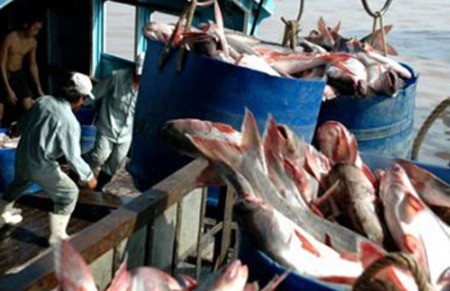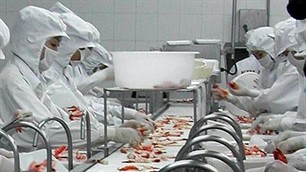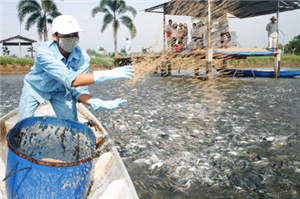 |
| Photo by: vneconomy |
The Mekong river delta enjoys many advantages for raising tra fish. The three major tra fish raising areas are Dong Thap, An Giang and Can Tho city which provide a large number of materials for seafood processors. Since 2003, these three major tra breeding regions have applied international standards to their production. Many tra fish farming areas now meet the Global Good Agricultural Practices or GAP and the Safe Quality Food SQF 1000 standards.
In Dong Thap Province, nine out of 11 companies that have the capacity to produce seafood for export have either filed applications to acquire the Global GAP certification or have been awarded the certification by Bureau Veritas. Four of them received the Global GAP certification for their production processes products this year, and the remaining five will complete filing their applications early this year. An Giang Province has its own model – the An Giang Pure Pangasius Union (APPU) – to produce tra fish under the SQF 1000 or Global GAP standards. Mr. Le Chi Binh, the Vice Chairman of An Giang Fisheries Association said that the province has applied health and safety standards in tra fish farming. “We have been working out specific programs to produce safe fish since 2000, under which an environmental impact assessment is required for industrial fish farming and an environment review is required for individual fish farmers. In addition, since 2003, AN Giang province has applied the SQF standards for fish farming and we received the certificate of SQF standards in 2004. This standard is internationally recognized for being environmentally friendly and we aim to obtain the GLOBAL GAP standard later this year”, Binh said.
 |
| Photo by: VOV |
Vietnamese tra fish are now available in 120 countries and meet the strict standards of difficult new markets including the EU, Australia and Japan. Vietnamese exports of tra fish now reach 1.5 billion USD annually. Over the past few years, the government has introduced a strategy for tra fish to ensure sustainable development for the sector. Mr Duong Nghia Quoc, Director of Dong Thap Province’s Department of Agriculture and Rural Development is optimistic about the future development. “Thanks to good quality and competitive prices, our markets have expanded. Vietnamese tra fish has been voted as one of the most popular seafood products in the European and American markets,” he said.
Tra fish farmers in the Mekong River Delta have worked with domestic and foreign organizations to develop safe tra fish farming areas that meet international standards. Many farmers have invested in upgrading their waste treatment systems and pay attention to the safety of the water. They have also paid attention to the use of chemicals and drugs when dealing with diseases, food safety issues and the density of breeding areas to ensure the quality of their products. Can Tho University is working hard to help farmers. “Last year, Can Tho Unviersity worked with the Fisheries Cultivation Institute No 2 to instruct farmers to apply the model “Better Management Practices” to reduce production costs, improve fish farms and link farmers together who can eventually prove the quality of their products,” said Doctor Nguyen Thanh Phuong, Head of the Fisheries Department.
 |
| Photo by: nongnghiepvietnam |
To ensure a sustainable Tra fish industry, the Ministry of Agriculture and Rural Development recommended that producers should attach more importance to foreign markets, keep a close watch on the domestic market, strengthen links with exporters, apply advance technologies, protect the environment, and reduce costs. Experts have also noted that it is necessary to draw up appropriate criteria on the cultivation of Tra fish in line with global standards to avoid anti-dumping taxes and technical barriers.
Story by: Mai Phuong